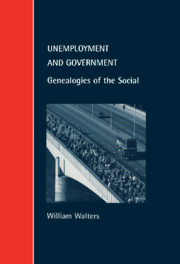Book contents
- Frontmatter
- Contents
- Acknowledgements
- Introduction
- 1 The Discovery of Unemployment
- 2 Inventing Unemployment: The Birth of the Labour Exchange
- 3 Governing Unemployment as a ‘Risk’
- 4 Governing Through the Long-Term Unemployed: Unemployment Between the Wars
- 5 Unemployment and its Spaces
- 6 Governing Divided Societies: The New Deal
- Conclusion
- Notes
- Index
Conclusion
Published online by Cambridge University Press: 07 September 2010
- Frontmatter
- Contents
- Acknowledgements
- Introduction
- 1 The Discovery of Unemployment
- 2 Inventing Unemployment: The Birth of the Labour Exchange
- 3 Governing Unemployment as a ‘Risk’
- 4 Governing Through the Long-Term Unemployed: Unemployment Between the Wars
- 5 Unemployment and its Spaces
- 6 Governing Divided Societies: The New Deal
- Conclusion
- Notes
- Index
Summary
In his important and careful attempt to reconstruct key aspects of the social experience of British unemployment over the last 200 years, the historian John Burnett has underlined what he sees as the remarkable degree of continuity marking the history of this phenomenon. ‘History is about continuity as well as change’, he writes, ‘and this study of unemployment illustrates some remarkable consistencies over time in public attitudes and personal responses despite the major economic and social transformations which have occurred during the last two centuries.’
This impression of continuity which tends to attach itself to the history of unemployment is only reinforced by our habit of thinking about unemployment in terms of numbers. Crime rates, poverty statistics, data about health, and, increasingly, information about markets – all regularly feature in the social and political life of nations. However, few of these series quite rival the impact or the cultural salience of the unemployment rate. While serious doubts about its accuracy have arisen in recent years, in part linked to concerns that it has been rather cynically manipulated for political reasons, the unemployment rate remains a key social indicator. Yet it is precisely this social perception that unemployment is, essentially, a number, a quantity, which makes it so familiar. The rate may go up or down, the distribution may change, but the thing remains essentially there.
- Type
- Chapter
- Information
- Unemployment and GovernmentGenealogies of the Social, pp. 144 - 156Publisher: Cambridge University PressPrint publication year: 2000

